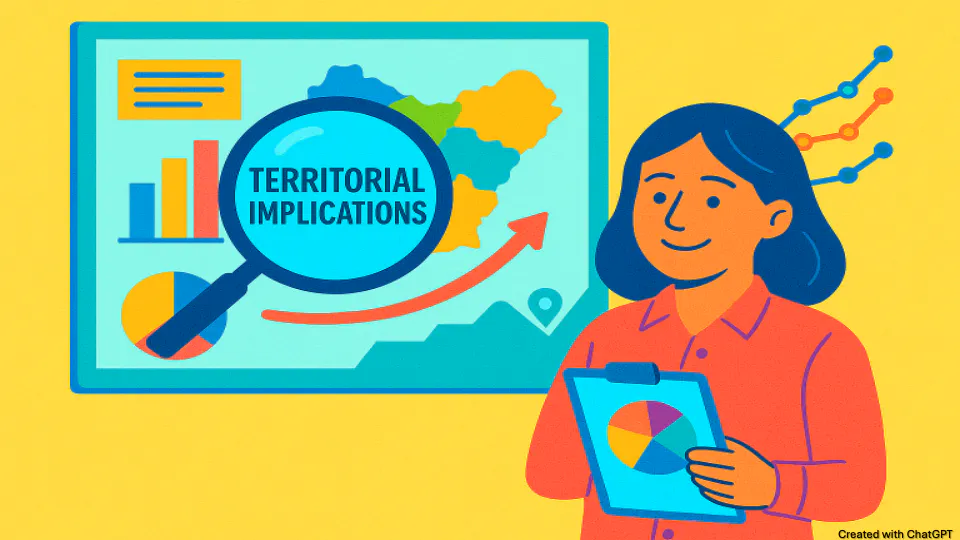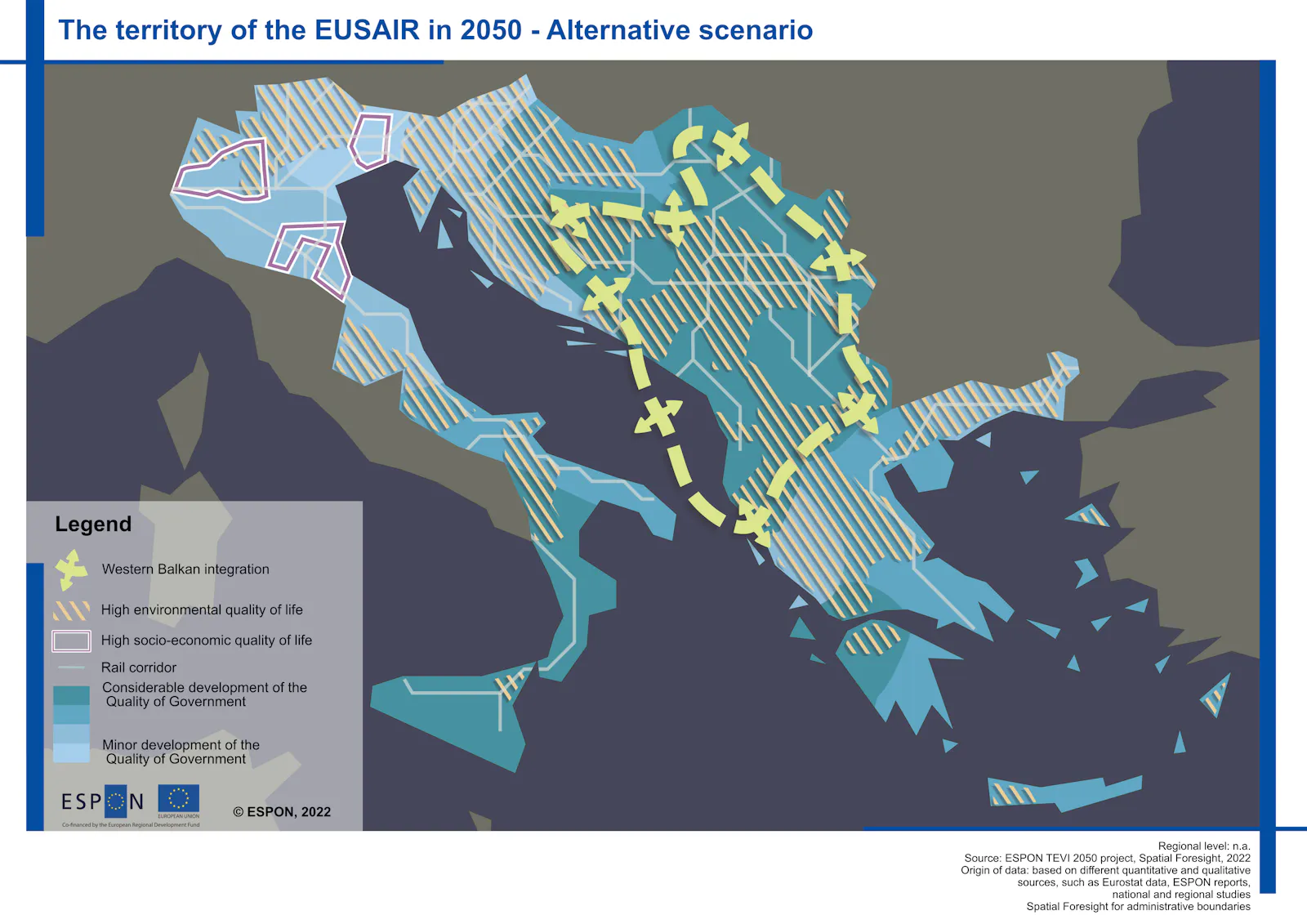Future proof? Not without territory!
April 2025

Foresight and scenarios are paramount tools to imagine positive futures and combat presentism. They are also imperative for a Preparedness Union, as highlighted in the respective European Commission Communication, when they are based on research, evidence and scientific advice. However, what is often missing from scenarios, but is fundamental for policy making, is their territorial implications. Trends and developments, but also futures may look differently for different territories, influencing eventually policy decisions in different ways. In our latest series of blogposts ‘We imagine desirable futures (Abre numa nova janela)’ we explore several positive futures of the EU. In this blogpost we argue that exploring the territorial implications can make the picture complete and is essential if political decisions aim at transforming territories.
Is your scenario territory-proof?
Foresight activities, scenario development, trend analyses, horizon scanning, wild cards, black swans and grey rhinos are but a few buzzwords that swept in our lives over the last years. Foresight and future literacy have infused in our daily discourse, reshaping the way we have been thinking about tomorrow. Scenarios, in particular, have taken a central stage in policy making, business strategies but also in regional planning as necessary tools to navigate future uncertainties. Today’s continuously transforming world, characterised by poly-crises, environmental challenges, political and technological shifts and new dynamics asks for careful planning. Indeed, anticipating the future is not only interesting and intriguing. It is necessary.
Nevertheless, thinking long-term remains a difficult task for people. Our attitude towards the future is often described as ‘tempus nullius’ or nobody’s time, with policy makers being trapped to presentism and political short-sightedness, as pointed out by Krznaric in his book The Good Ancestor. Here is where scenarios and foresight come in as an antidote and allow the exploration of several different possible and plausible paths. Scenarios do not predict the future, nor make accurate prognosis. Instead, they unfreeze our mental barriers and inspire us by mapping different futures. This helps us prepare for what’s next and guide our decisions.
But here's the catch. Despite the wealth of information, something crucial seems often to be missing. While trends and scenarios show possible directions, it is their implications on the different territories that will determine the effects these futures may unfold.
Picture this. It is 2050 and citizens of the Danube and the Adriatic Ionian macro-regions decide to put their quality of life as their top priority. To do that they focus on fostering green and social wellbeing, where environmental sustainability and social welfare are key guiding principles. Would the futures be the same for both regions? Should the policy responses be the same? The ESPON Project on ‘Territorial Scenarios for the Danube and the Adriatic Ionian macro-regions gave some answers, as shown in the maps below.


For the Danube macro-region, for example, this would mean greening the industrial sites and restructure the traditional manufacturing, hence territories that are home to industries or have high manufacturing rates may confront job displacements or economic changes, while at the same time think of opportunities in new economic sectors. For the Adriatic Ionian macro-region, on the other hand, and looking at the economic profile of the region, this will imply the adoption of sustainable tourism practices and the management of tourist flows to preserve the pristine environment of the region, which may have consequences on local economies relying on mass tourism, which asks for economic diversification.
These contrasting implications on the two regions are just brief examples that showcase how same trends may play differently in different territories, underscoring the need for looking carefully into the territorial implications. At the same time, looking whether territories are urban, rural, insular or mountainous, to name a few, may further nuance these effects.
Therefore, the question to answer here, is what does this trend mean for me or for my place? The example highlights that scenarios should not be just products of our imagination, let alone go for one-size-fits-all solutions. Looking at the territorial realities will contribute to avoiding mistakes and grasping opportunities that are rather tailored to the needs of different territories. Ignoring this, may risk that scenarios may not be able to be translated into reality.
Imagining scenarios informs.
Imagining territorial scenarios transforms.
Therefore, while imagining scenarios helps us understand the future, we need to take this exercise a step further. We need to move from being informed to be able to transform the future through our actions. A key role to that plays the identification of possible territorial implications which can actually link the different trends and developments with the local or regional dynamics and even make them more understandable. This can only be done when combined with evidence, territorial knowledge and data and expert judgement.
How can we effectively include territorial implications to scenarios? One approach is to utilise elements of territorial impact assessments. Territorial impact assessments help to assess any positive or negative, intended or unintended territorial impacts of a policy. The method aims at assessing potential effects of polices and understand any territorial dimensions and impacts. Looking at the exposure and sensitivity of different policies and combining this with relevant data can help us identify possible implications that the different developments may unfold in different territories.
Another effective approach regards the co-creation method. Involving local and regional players, policymakers, businesses from the outset of the scenario development helps bridging the expert knowledge with the local characteristics. Engaging relevant players adds a local and a realistic touch to the scenarios stories, making them even more impactful and eventually useful. Through co-creation, citizens have their own say in the development of their territories, they guide directions, they feel able to shape their own future and develop a shared understanding among different players. The combination of these methods is one of the ways for carrying out territorial scenarios. The methods have been used by Spatial Foresight in a number of projects and settings, such as ESPON projects on the development of territorial scenarios for the Baltic Sea Region (BT2050), or the ESPON Territorial Scenarios for the Danube and the Adriatic Ionian macro-regions (TEVI2050) (see also earlier blogposts here (Abre numa nova janela) and here (Abre numa nova janela)), but also a number of foresight workshops (Replacing GDP with a quality of life index).
Summing up, territorial scenarios have the added value of a transformative potential. This is because they touch ground with territorial realities. Furthermore, collaborative futures, backed up with data and sources relevant for respective territories have the power to transform places as more informed decisions can be taken. At the end of the day, it lies on the hands of the policy makers to filter the necessary information, take actions and develop policies and concrete plans that lead to a desirable future for their citizens. In that respect, territorial scenarios take a closer look to the places that policymakers represent, making their decisions more territorially connected and impactful.
by Maria Toptsidou
https://steadyhq.com/en/spatialforesight/posts/628e55e4-6816-4e63-9a7d-f8b67eb28b91 (Abre numa nova janela)

